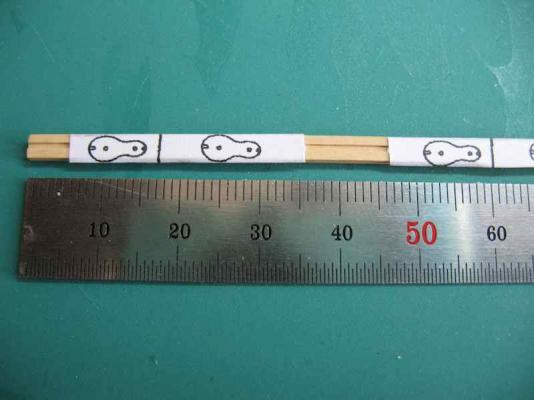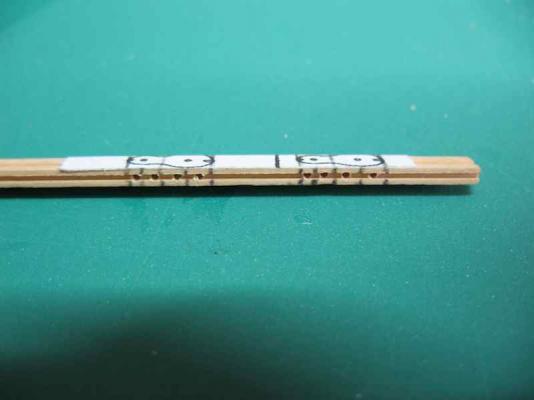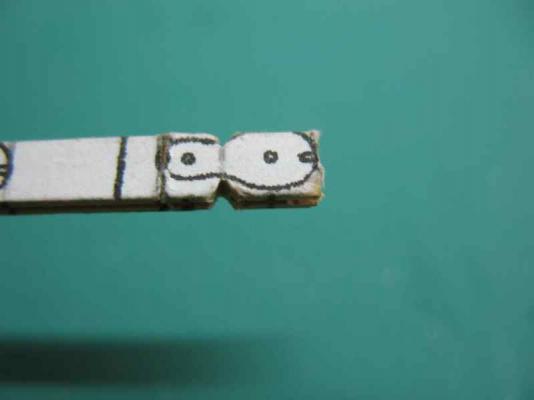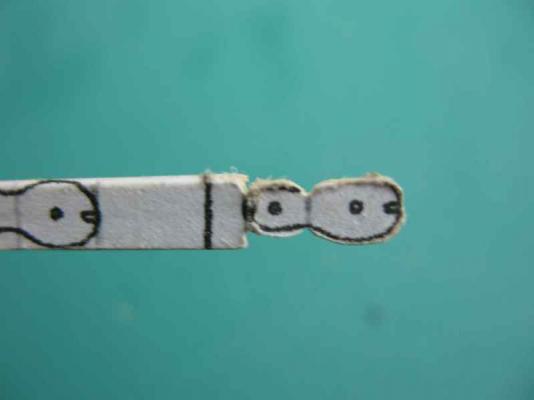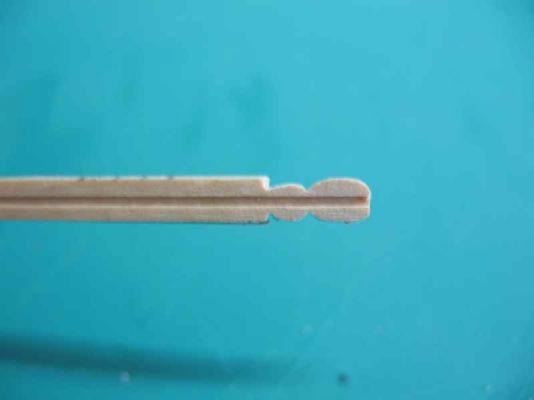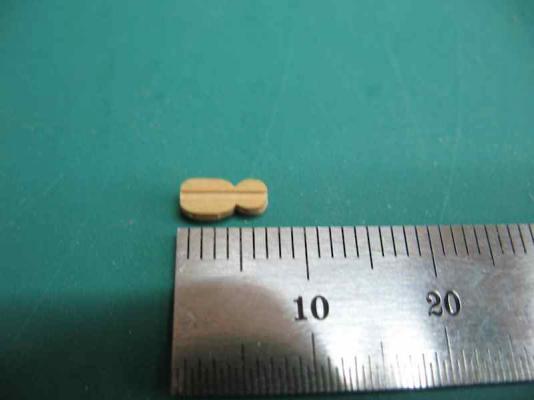-
Posts
4,891 -
Joined
-
Last visited
Content Type
Profiles
Forums
Gallery
Events
Everything posted by gjdale
-
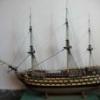
Victory by mikec - FINISHED - Mamoli
gjdale replied to mikec's topic in - Kit build logs for subjects built from 1751 - 1800
Mike, B.E. has answered on which flags where. As far as "how" goes, I believe that haliards were run through sheaves in the Mast trucks (the bit on top of the masts). -
Hi Gil, As always your log is both informative and instructive. The "pin to mast" idea looks to be a really good one. I may just unrig my fore topsail and topgallant yards to retro fit these. As I'm now leaning towards the fitting of brace pendants, it would be easier to do this off the model anyway, so no real loss in unrigging these yards.
- 755 replies
-
- finished
- caldercraft
-
(and 1 more)
Tagged with:
-
Good to see progress on Aggy Sjors. Now ask your better half to get cracking on her Half Moon again!
- 1,616 replies
-
- caldercraft
- agamemnon
-
(and 1 more)
Tagged with:
-
Sounds like you've learned the most important lesson of all Sean - if YOU aren't happy with something, rip it out and do it over, otherwise it will bug you forever! Good move on the gratings. I'm interested in hearing/seeing more about your rope walk. How some pics of the machine and the results? What design did you use? Good luck with your IT exam. Your ship will wait patiently for your return, and so will we.
-
Thanks B.E., That kind of says that both Longridge and Lees are correct! Which means that if I were to follow as written by Longridge, I would not be incorrect....... Hmmmmm. I've been around the buoy on this so many times in my head that I'm getting dizzy. I think now there is sufficient evidence to suggest that for Victory, Longridge may be taken as being correct on this point (except I shall use a long tackle block in lieu of the common double block). Many thanks for your input B.E.
-
Looking very good David. It's interesting to see the different approaches to rigging among us as a group of modellers - much as it would have been among the various ship's Captains.
- 439 replies
-
- victory
- caldercraft
-
(and 1 more)
Tagged with:
-
Hi John, Sorry to hear of your computer problems - one of the main reasons I migrated to Mac years ago (to get away from Windoze!).
- 2,250 replies
-
- model shipways
- Charles W Morgan
-
(and 1 more)
Tagged with:
-
Hi Ed, I've just received my copy of Naiad Vol 2 - a most welcome belated Christmas present. What a beautiful job you've done with this book! I think it even ups the standard from Vol 1, and that was terrific itself. I've only had the chance to skim and dip into a few sections so far, but the way you've written this makes it a superb general reference book that will become a primary resource for me in the months and years ahead. Thank you so very much for making this contribution to the ship modelling community. Well done Sir!
-
Thanks Lawrence and Jeff. Jeff, I also looked at McKay and he generally is in agreement with Longridge. Thanks for your sketch and thoughts on how it might work. I would differ a little from your interpretation of McKay's table though. I think the quantities he refers to take into account both port and starboard sides of the yard, so there would be one inner and two outer tricing line blocks on each side (if I'm correct). The more I look at this, the more I'm inclined to follow Antscherl's interpretation...... Still hoping one of you guys/gals will weigh in with some illuminating thoughts....
-
Beautiful work as always Rusty. Re self-centering vs independent chucks, I'm a rank beginner with all this machinery so can't really offer an opinion of experience. The "experts" all seem to reckon that the independent jaws are more accurate. So far, I've only used self-centering ones, but as I said my experience is very limited.
- 421 replies
-
- granado
- bomb ketch
-
(and 2 more)
Tagged with:
-
Ouch John. Sounds like the sort of thing I would do! At least it will be hidden from view as you say, and only you and me and the other 9,322 MSW members will ever know.
- 745 replies
-
- francis pritt
- mission ship
-
(and 1 more)
Tagged with:
-
Happy New Year Augie. She's looking fabulous. Lovely job on the paintwork.
- 2,191 replies
-
- confederacy
- Model Shipways
-
(and 1 more)
Tagged with:
-
Following on from the most useful discussion on Yard Tackle Pendants and Brace Pendants, I think I've decided to show the Yard Tackle Pendants "triced up". But that leads to two more quandaries...... The first of these is to do with how the tricing was actually achieved. Lees (pg 71) says that the outer tricing line was attached to the Pendant just by the (yard tackle) block, reeved through the outer tricing line block (seized to the yard close to where the pendant would come to the yard) and then belayed in the top. He goes on to say that the inner tricing line was attached to the fall close to the hook block and reeves through the inner tricing line block. He doesn't indicate where the inner tricing line block is attached, nor where it belays, although the diagram on the same page shows the block as being on the yard close to the mast and the the tricing line then leading to the deck. In a description of the the rigging of HMS Medway (1742) on pg 175, he seems to contradict himself somewhat by stating that the outer tricing line belays "to the fore topsail sheet bits next to the upright". The same page also indicates that the inner tricing line belays to the third shroud of the foremast. Longridge (pg 242), on the other hand, says the outer tricing line is made fast to the pendant just above the (yard tackle) block, reeved through a 7" single block just outside the quarter iron, through another 7" block lashed to the first shroud just below the futtock stave and leads down on deck where it is belayed around the first lower shroud above the deadeye. The inner tricing line is made fast just above the hook block, reeved through another 7" block on the same shroud and belays on deck around the second lower shroud above the deadeye. Antscherl agrees with Lees, including the contradiction of whether the outer tricing line belays in the top or on the fore topsail sheet bits. Confused yet? I sure am!!!! The next issue is the Yard Tackle Pendant Block itself. Longridge quite clearly says that this is a 13" double block. Lees describes it as a long-tackle block. Antscherl says that at first he was confused by Steel's description into thinking that the blocks were conventional double ones while in fact these were long tackle blocks. He doesn't offer an opinion as to what convinced him of this, but does add that these were "double thin blocks", meaning they are narrower than a standard or common block of the same size. I'm inclined to go with Lees/Antsherl on this and use a long-tackle block. That then leads to the next question - what size/proportions should they be? Enter Steel. Steel describes Long Tackle Blocks as being two thirds longer than the proportion for a single block. My reckoning says then that if Longridge is describing a 13" (conventional) double block, then the Long Tackle Block would be roughly the length of a 13" block and a 10" block combined (or about 22 - 23"). At scale this equates to using the equivalent of a 5/32" and 1/8" block length, which is a total length of roughly 9/32"or 7mm. A comparison to Antscherl's choice of a 15" block for a Swan class would seem to be about right. So, how to make them then...... Noting that the blocks need to be thinner than standard, I decided to use the size of the smaller block for this dimension. I found a drawing of a Long Tackle Block and scaled it using the photocopier until it was the right overall length. I then prepared some Boxwood stock 1/16" x 1/8" and made grooves for stropping and sheaves, and stuck on the pattern: Next, I marked the divisions of the block onto the edges and drilled 0.5mm holes for the sheaves: Then I used a razor saw to make small cuts at the extremities and the "centre" of the block, and used this as a starting point for a triangular needle file to start shaping the block: I continued to file the shape until it was "almost there": At that point I was able to snap off the block from the stock and finish off the end: And here's the final result, not perfect, but I think they'll do: All I need to do now is replace the existing Yard Tackle Pendants/blocks with the new Long Tackle Blocks and then sort out just how the whole tricing thing is going to work....... Oh, and while I'm at it, I'll probably replace the Brace Blocks with Brace Pendants/Blocks as well. Okay, I'm exhausted just thinking about this. Any and all opinions welcome.
-
Welcome back Bug. Nice to see your log back - thanks for taking the time and effort to re-post.
- 274 replies
-
- Santa Maria
- Artesania Latina
-
(and 2 more)
Tagged with:
-
Great to see this one finally underway Sjors. I'm sure it will be an enjoyable build for you, especially with your little "upgrade" kit
- 1,616 replies
-
- caldercraft
- agamemnon
-
(and 1 more)
Tagged with:
-
Great decision to go with the Sherline Rusty, you won't regret it. As for size, it's very much a personal decision. I went with the longer bed "just in case" on the basis that if I didn't end up needing the extra length then nothing lost, but if I'd gone the other way,........... Also, space wasn't an issue for me. Of course, you're going to become addicted to adding accessories now too!
- 421 replies
-
- granado
- bomb ketch
-
(and 2 more)
Tagged with:
-
That's a very nice looking set of spars there Len. Best wishes for 2014 - may it be full of rewarding modelling.
- 122 replies
-
- bellerophon
- victory models
-
(and 1 more)
Tagged with:
-
Looks great Bob. Best wishes for the New Year.
- 1,477 replies
-
- essex
- model shipways
-
(and 1 more)
Tagged with:
-
Hi Mike, Thanks for dropping by. I haven't done the quarter davits yet. Still considering how I will tackle this one as I agree the kit instructions are somewhat lacking here. I will probably be guided by Longridge for this aspect.
-
Looking good Sean, Your decision on treenails was a good one in my opinion. The Danish oil seems to come up very nicely too, Re your canon question, it is the canons that sit on carriages you need to be careful with. Those with only dummy barrels will be able to be fitted into the gun port frames easily from the outside (though I would check the fit of the dummy barrel flange into the metal hole for each frame before fitting to the hull). Those that are on carriages and will later be covered by another deck are the ones to fit early. The instructions suggest that these can be fitted through the gunports from outside. They can't. Now is also a good time to make sure your gunports are set at the right height. I understand that you are going to go ahead with the supplied metal gunport frames, but don't trust the notches on the frames as a height guide. I suggest you make up a gun/carriage assembly and use this to ensure each port is at the right height. Keep up the great work - it's looking really good.
-
Great work Sjors, You'll be finished this one in no time. Oh wait........I seem to recall that the Sjors shipyard will be commencing work on the Aggy from 01 Jan 14......maybe this one will take a little longer then
- 1,873 replies
-
- occre
- san ildefonso
-
(and 1 more)
Tagged with:
About us
Modelshipworld - Advancing Ship Modeling through Research
SSL Secured
Your security is important for us so this Website is SSL-Secured
NRG Mailing Address
Nautical Research Guild
237 South Lincoln Street
Westmont IL, 60559-1917
Model Ship World ® and the MSW logo are Registered Trademarks, and belong to the Nautical Research Guild (United States Patent and Trademark Office: No. 6,929,264 & No. 6,929,274, registered Dec. 20, 2022)
Helpful Links
About the NRG
If you enjoy building ship models that are historically accurate as well as beautiful, then The Nautical Research Guild (NRG) is just right for you.
The Guild is a non-profit educational organization whose mission is to “Advance Ship Modeling Through Research”. We provide support to our members in their efforts to raise the quality of their model ships.
The Nautical Research Guild has published our world-renowned quarterly magazine, The Nautical Research Journal, since 1955. The pages of the Journal are full of articles by accomplished ship modelers who show you how they create those exquisite details on their models, and by maritime historians who show you the correct details to build. The Journal is available in both print and digital editions. Go to the NRG web site (www.thenrg.org) to download a complimentary digital copy of the Journal. The NRG also publishes plan sets, books and compilations of back issues of the Journal and the former Ships in Scale and Model Ship Builder magazines.



